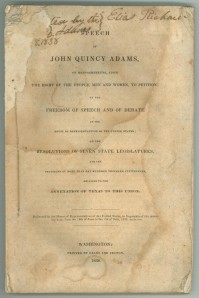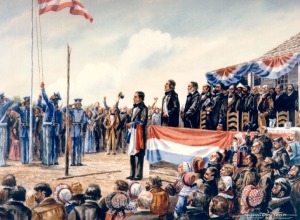March 21 1846
Mark Fernandes
After all the concerns and problems our nation had, President Polk signed the joint resolution, and Texas finally became our 28th state on December 29th 1845 (3). Although Republic of Texas wanted to be a part of the United States of America since the independence from Mexico in 1836, both nations faced a lot of problems. One of the main problem was Mexico. Although Texas freed itself from Mexico, Mexico was still very influential both to Republic of Texas and the United States. In 1838, senator William C. Preston introduced a resolution for a tripartite treaty between the U.S./Mexico/Texas in the U.S. Senate (6). However, when the measure was tabled, many politicians, including our former president John Quincy Adams, now as a congressman, spoke against the annexation of Texas. It was very surprising to see John Quincy Adams John speaking against the annexation because when he was the president, he wanted to purchase Texas from Mexico. Quincy Adams said, “This annexation will lead to a war between the U.S. and Mexico. (2) Also, Texas is nothing but the misbegotten and illegitimate progeny of the slaveholding South. Texas still legally belongs to Mexico, and abolitionists here and I will fight any attempts to put the United States in the position of stealing part of another country.(6) Moreover, Texas is the Botany Bay of the United States.” With all the negative actions from the U.S congress, Republic of Texas had to withdraw the offer of annexation. (6)

Retrieved from : http://texashistory.unt.edu/ark:/67531/metapth31816/m1/1/
Because Republic of Texas was still under the threats of Mexico, Republic of Texas looked for another way to protect itself. It was Great Britain. Great Britain was opposed to annexation and even considered the use of force to prevent it(7). They did not wish to add Texas to the British Empire, but they wanted to prevent the expansion of the United States, to reap commercial advantages from Texas trade, and to tamper with the American tariff system and the institution of slavery(1). Deciding that Texas should not be a satellite of Great Britain, president John Tyler proposed annexation(1). However the the negotiation of a treaty of annexation was rejected by the United States Senate (35 to 16) in June 1844 again. President John tyler’s presidency ended without solving the problem with annexation of Texas and left it to the future president. Annexation then became an issue in the presidential election of 1844; James K. Polk, who favored annexation, was elected(5).
With many attempts and amendments of Joint Resolution, The United States Congress passed the annexation resolution on February 28, 1845, an Andrew Jackson Donelson proceeded to Texas to urge acceptance of the offer(2). Meanwhile, the Great Briten still wanted to prevent the annexation. However, the public opinion in Texas, fanned by special agents from the United States, demanded acceptance of the American offer and was unwilling to change its mind(6). One of crowd welcoming Andrew Jackson Donelson said, “Finally, now we do not have to worry about having a war with Mexico. I am not saying we were afraid of having a war with Mexico, but now we have a guaranteed safety. For almost past 10 years, we had to just watch helplessly Mexican troops crossing the border and threatening us with big rifles that killed our men who bravely fought for independence of Texas. We believe that our president Arson Jones will make a great choice with Andrew Jackson.” The number of people welcoming Andrew Jackson Donelson was expressing the true opinion of Republic of Texas(4).
Although Cuevas-Smith treaty between Mexico and Texas was signed guaranteeing Texas independence so long as it remains a separate republic on may 19, about three months later, both Texas congress and convention accepted the offer from the U.S.(1).The tally of vote was overwhelmingly favored the annexation to the U.S(4). On Feb 19 1846, The transfer of government completed when Governor J. Pinckney Henderson takes the oath of office. He finished his oath whit this quote, “The final act in this great drama is now performed; the Republic of Texas is no more.”(4).
There is still one problem we are facing though. It is a war with Mexico. After rejecting the Cuevas-Smith treaty, Mexico took the rejection of treaty as an sigh of declaration of war. The tension between the Mexico and the U.S is getting tighter and tighter. War should not be a solution to this problem, but when people already know that the war is inevitable.
———-
Sources:
1) Edgefield advertiser. (Edgefield, S.C.), 29 May 1844. 15 Nov. 2013 Chronicling America: Historic American Newspapers. Lib. of Congress. <http://chroniclingamerica.loc.gov/lccn/sn84026897/1844-05-29/ed-1/seq-2/>
2)”Part 4: A Treaty of Annexation.” – Texas State Library and Archives Commission. N.p., 5 Aug. 2011. Web. 15 Nov. 2013. <https://www.tsl.state.tx.us/exhibits/annexation/part4/page1.html>.
3)”Annexation of Texas History – Annexation of Texas Facts – Annexation of Texas Information.” Annexation of Texas History – Annexation of Texas Facts – Annexation of Texas Information. Monaco Rare coin, n.d. Web. 15 Nov. 2013. <http://www.monacorarecoins.com/rare-coin-articles/james-polk-annexation-of-texas/>.
4)”Annexation Process: 1836-1845 A Summary Timeline.” Annexation Process: 1836-1845 A Summary Timeline. N.p., n.d. Web. 14 Nov. 2013. <https://www.tsl.state.tx.us/ref/abouttx/annexation/timeline.html>.
5)”Part 3: An International Matter.” – Texas State Library and Archives Commission. N.p., 5 Apr. 2011. Web. 15 Nov. 2013. <https://www.tsl.state.tx.us/exhibits/annexation/part3/page1.html>.
6)Neu, C.T. “ANNEXATION.” NEU, C. T.. Texas State Historical Association, n.d. Web. 13 Nov. 2013. <https://www.tshaonline.org/handbook/online/articles/mga02>.
7)”Annexation of Texas.” Annexation of Texas. N.p., n.d. Web. 15 Nov. 2013. <http://www.u-s-history.com/pages/h302.html>.



